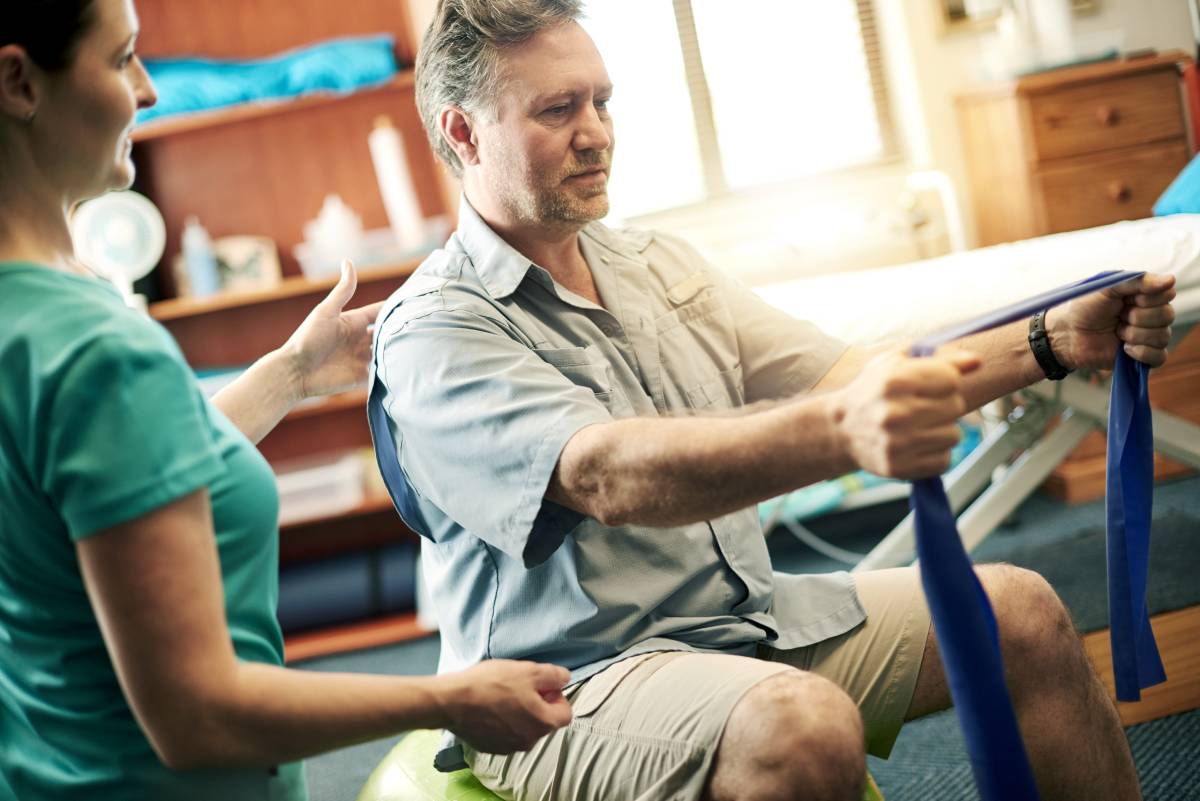Arthritis Management with Physical Therapy

Physical therapy (PT) is a central form of treatment used in arthritis management. From prevention to postoperative rehabilitation, PT can be an appropriate care technique at all stages of the disease [1]. Generally, PT seeks to minimize the impact of arthritis-related disability while improving patients’ functional abilities [1]. This article will discuss three forms of arthritis and helpful findings that can guide physical therapists in designing treatment plans.
Rheumatoid arthritis (RA) is the most common form of inflammatory arthritis [2]. It results in chronic joint inflammation and injury to the body’s organs [2]. Because it can cause sleep disturbances, fatigue, and pain, RA typically interferes with patients’ body function, resulting in decreased cardiovascular endurance, range of motion, and strength [1, 2]. Physical activity is highly recommended for patients with RA: It can increase muscle strength, aerobic capacity, and health-related quality of life [2].
Several forms of physical therapy have shown success in treating RA. One study found that community-based interventions led to significant short-term improvements in knowledge, morning stiffness, and self-efficacy compared to a waiting list control group [3]. Home-based individual interventions focused on education, pain relief, and exercise have also resulted in similar improvements up to a year after just a six-week program [4]. Paraffin heat therapy can also provide pain relief, and, when paired with exercise, promote improved grip function and range of motion [1].
Osteoarthritis (OA) is a complex, multifactorial disorder with joint-specific effects [5]. It results in similar cardiovascular, strength-based, and motion-based impairments as RA [1]. Osteoarthritis treatment primarily consists of pain management until joint replacement becomes necessary [5]. Physical therapy is an important means of preventing further deterioration and eliminating or, at the very least, delaying surgical intervention until it is absolutely necessary [1].
Aerobic and strengthening exercises are a particularly successful form of OA management [1]. In patients with knee OA, aerobic exercise performed over 18 months resulted in decreased disability and pain, along with improved function [1]. Strength exercises have similar positive results [1]. Compared to individual treatments, small-group interventions have comparable results in terms of walking speed and knee extensor strength when used to treat knee OA patients [6]. Additionally, ultrasound therapy can have beneficial effects on patients’ range of motion and pain levels [1].
In the context of physical therapy, psoriatic arthritis (PsA) is less studied than OA and RA [7]. PsA is a debilitating inflammatory disease that results in many extra-articular and musculoskeletal manifestations [7, 8]. It is associated with unhealthy levels of smoking and drinking, as well as obesity and sedentariness [7]. While pharmacological remedies tend to be effective in treating PsA, additional treatment modalities may further restore quality of life and function, especially for patients with certain comorbidities [7].
Physical therapy, particularly in the form of exercise therapy, is an essential strategy for managing PsA and other types of inflammatory arthritis [7]. Choosing the right exercise is essential to successful disease management. While high-intensity interval training does not appear to improve pain and disease activity, it may reduce fatigue [9]. Conversely, resistance exercise programs targeting the trunk and limbs may increase patients’ quality of life, axial disease activity, and functional capacity [10]. They can also reduce pain, but they may not affect disease activity or muscle strength [10].
Given the pronounced variation across different forms of arthritis and people, it is impossible to prescribe a universal physical therapy program for arthritis patients. Instead, physical therapists must develop regimens that attend to patients’ unique conditions [1].
References
[1] B. Greene and S. S. Lim, “The Role of Physical Therapy in Management of Patients with Osteoarthritis and Rheumatoid Arthritis,” Bulletin on the Rheumatic Disease, vol. 52, no. 4, p. 1-7, 2003. [Online]. Available: https://bit.ly/3FETHKv.
[2] S. McKenna, G. Kelly, and N. Kennedy, “A survey of physiotherapists’ current management and the promotion of physical activity, in people with rheumatoid arthritis,” Disability and Rehabilitation, vol. 41, no. 18, p. 2183-2191, 2019. [Online]. Available: https://doi.org/10.1080/09638288.2018.1461258.
[3] M. J. Bell et al., “A randomized controlled trial to evaluate the efficacy of community based physical therapy in the treatment of people with rheumatoid arthritis,” The Journal of Rheumatology, vol. 25, no. 2, p. 231-237, February 1998. [Online]. Available: https://bit.ly/3HR0yCG.
[4] S. C. Lineker et al., “Improvements following short term home based physical therapy are maintained at one year in people with moderate to severe rheumatoid arthritis,” The Journal of Rheumatology, vol. 28, no. 1, p. 165-168, January 2001. [Online]. Available: https://bit.ly/3pcAfhN.
[5] S. Glyn-Jones et al., “Osteoarthritis,” The Lancet, vol. 386, no. 9991, p. 376-387, July 2015. [Online]. Available: https://doi.org/10.1016/S0140-6736(14)60802-3.
[6] M. Fransen, J. Crosbie, and J. Edmonds, “Physical therapy is effective for patients with osteoarthritis of the knee: a randomized controlled clinical trial,” The Journal of Rheumatology, vol. 28, no. 1, p. 156-164, January 2001. [Online]. Available: https://bit.ly/3xgmQZk.
[7] F. M. Perrotta et al., “New Insights in Physical Therapy and Rehabilitation in Psoriatic Arthritis: A Review,” Rheumatology and Therapy, vol. 8, p. 639-649, March 2021. [Online]. Available: https://doi.org/10.1007/s40744-021-00298-9.
[8] P. Krakowski et al., “Psoriatic arthritis – new perspectives,” Archives of Medical Science, vol. 15, no. 3, p. 580-589, August 2018. [Online]. Available: https://doi.org/10.5114/aoms.2018.77725.
[9] R. S. Thomsen et al., “Impact of high-intensity interval training on disease activity and disease in patients with psoriatic arthritis: a randomized controlled trial,” Arthritis Care Research, vol. 71, no. 4, p. 530-537, June 2018. [Online]. Available: https://doi.org/10.1002/acr.23614.
[10] D. Roger-Silva et al., “A resistance exercise program improves functional capacity of patients with psoriatic arthritis: a randomized controlled trial,” Clinical Rheumatology, vol. 37, no. 2, p. 389-395, November 2017. [Online]. Available: https://doi.org/10.1007/s10067-017-3917-x.
